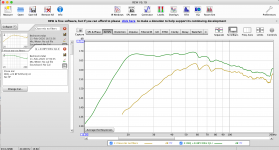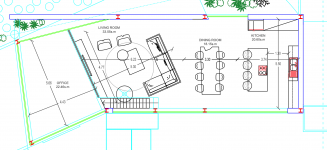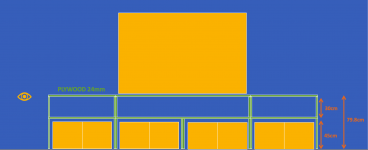Hi guys.
I am in the process of building our new house and the home theater will be be integrated in the living room. Because of the open plan layout the placement of the subwoofers is set under the tv, up against the wall.
There are 8 JBL CS1214 sealed subwoofers in total, driven by an inuke 6k. Just for reference I have attached a sample close mic response (ignore SPL).
To hide them in the room I would like to build a very solid cabinet under the tv, up against the wall and place 2 subwoofers in each 5-boundaries space, with vertical wood slats at the front.
How do I go to calculate the gain for multiple subs + boundary gain when there is 4 identical pairs with multiple boundaries per pair? Do you calculate the first pair with the spatial loading gain and then add 6db or 3db per doubling? Or do you calculate doubling (18db) plus 30db boundary gain? Is this considered co-location (6db per doubling) or not (3db per doubling)?
Looking forward to learning a few things! 😎
I am in the process of building our new house and the home theater will be be integrated in the living room. Because of the open plan layout the placement of the subwoofers is set under the tv, up against the wall.
There are 8 JBL CS1214 sealed subwoofers in total, driven by an inuke 6k. Just for reference I have attached a sample close mic response (ignore SPL).
To hide them in the room I would like to build a very solid cabinet under the tv, up against the wall and place 2 subwoofers in each 5-boundaries space, with vertical wood slats at the front.
How do I go to calculate the gain for multiple subs + boundary gain when there is 4 identical pairs with multiple boundaries per pair? Do you calculate the first pair with the spatial loading gain and then add 6db or 3db per doubling? Or do you calculate doubling (18db) plus 30db boundary gain? Is this considered co-location (6db per doubling) or not (3db per doubling)?
Looking forward to learning a few things! 😎
Attachments
Styjp,1)To hide them in the room I would like to build a very solid cabinet under the tv, up against the wall and place 2 subwoofers in each 5-boundaries space, with vertical wood slats at the front.
2)How do I go to calculate the gain for multiple subs + boundary gain when there is 4 identical pairs with multiple boundaries per pair? Do you calculate the first pair with the spatial loading gain and then add 6db or 3db per doubling?
3)Or do you calculate doubling (18db) plus 30db boundary gain?
4)Is this considered co-location (6db per doubling) or not (3db per doubling)?
1) A box built around a speaker with a semi- open front has 5 walls, but walls need to be a full wavelength long to be considered a boundary.
2)Free space plus boundary gain. Boundary gain is +6dB 1/2 space (one boundary away from all others), +12dB 1/4 space (floor/wall intersection) +18dB 1/8 space (corner load, three room boundaries). Multiple subs gain +3dB for doubling cone area (within 1/4 wavelength) and +3dB for doubling power, so 8 subs theoretically could gain 18 dB over one, before adding in boundary gain on top.
3) Doubling drivers and power gains 6dB, not 18. Boundary gain won't exceed 18 dB. Your depiction is 1/4 space, a maximum of +12 dB.
4) The drivers are "co-located" at low frequencies. At 100 Hz, the drivers would have to be within 1/4 wavelength, 33.9 inches (less than one meter) center to center to be considered "co-located".
All of the above will be of only academic use in your room, as it's modal response will create huge variations depending on listening and sub locations. The predicted 30dB "gain" could result in as deep of "loss" at your listening position, best do some measurements before you commit building into a regrettable location.


